Project 2 - Français
Icône de la protection de la Vierge à Puchly - 2008.
Vers
la fin du 16e siècle un homme malade habitait
dans une cabane au pied d’un tilleul. Un jour il a vu
une icône de la Vierge accrochée à l’arbre.
Il a prié devant cette icône et a été guéri.
L’icône a été reconnue comme miraculeuse
et une église orthodoxe a été bâtie à coté du
tilleul. Jusqu’à nos jours elle attire de nombreux
pèlerins.
En 2006 une grosse branche du tilleul s’est cassée
et elle a été récupérée
par le curé de la paroisse orthodoxe de Puchly le père
spirituel (batiushka) Paul Lapinski. En juillet 2007
le père m’a donné cette branche afin d’en
faire une sculpture. Je l’ai conservée et préparée
pour le travail, que je vais commencer sur place à Puchly
au printemps 2008.
Expertise de Dr Ewa Piroznikow – Université de
Bialystok : Le tilleul est malade et a besoin d’un traitement
qui est onéreux et beaucoup trop cher pour la petite
paroisse de Puchly. Toute personne qui voudrait contribuer au
sauvetage de cet arbre est priée de prendre contact
avec le Père
Pawel Lapinski, Paroisse Orthodoxe à Puchly (Pologne)
tél : (48) 85 681 55 27.
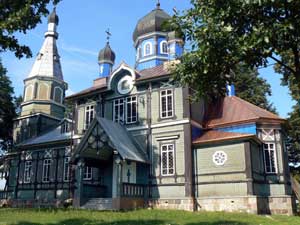
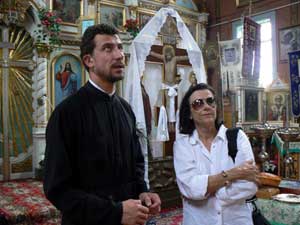
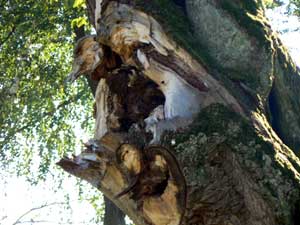
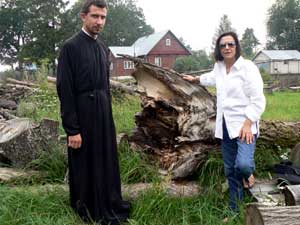
Le tilleul à petites feuilles (Tillia cordata)
apparaît dans les forêts naturelles dans le nord-est
de la Pologne ainsi que dans le reste du territoire polonais.
Sur les sols fertiles il peut atteindre l’age de 200
ans mais autour du tronc principal poussent des souches secondaires
qui peuvent devenir troncs principaux. Ainsi, dans le sens
génétique du terme, le même tilleul peut
vivre au même endroit plusieurs centaines d’années.
En Pologne cet arbre est souvent planté près
des habitations en raison de sa belle forme et la richesse
de sa couronne pour la production de miel. Dans les cultes
pré-chrétiens le tilleul était associé avec
l’élément féminin et la fécondité et
planté à l’occasion de la naissance d’une
fille pour lui porter bonheur. Le tilleul dans le village de
Puchly pousse à coté d’une église
orthodoxe et, selon la légende, est plus ancienne que
l’église même construite en bois au 16e
siècle. La forme de l’arbre indique qu’il
s’agit d’au moins la deuxième génération
qui s’est développée à partir des
souches secondaires d’un arbre déjà disparu.
Actuellement ce bel arbre d’une forme très originale
est en bonne condition générale quoi que le tronc
principal commence à pencher de coté et à pourrir à l’intérieur.
Dans cette situation les pluies ou les chutes de neige abondantes
pourraient le faire tomber. Le traitement indiqué consisterait
en enlèvement du bois pourri de l’intérieur,
en application sur les parois intérieures d’un
produit anti-champignon et le renforcement du tronc par des
anneaux en acier. Ainsi la vie de cet arbre-culte pourrait être
prolongée d’une bonne cinquantaine d’années.
Dr Ewa Piroznikow
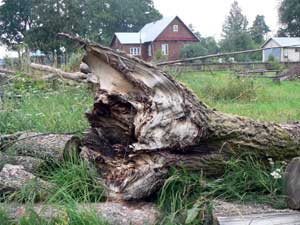
Project 2 - English
Icon
of Saint Mary Protection
- 2008
By the end of 16th century
a sick man that lived in the cabin next a lime tree saw the
icon of Saint Mary hanging on the tree. He pried to the icon
and was healed.The icon was recognised as miraculous and an
Orthodox church was built next to the tree. Many pilgrims are
still visiting the church.
In 2006 a big branch broke away of the
tree and was kept by the Orthodox vicar of the church in
Puchly the Spiritual Father (Batiushka)
Paul Lapinski. In 2007 the father gave this branch to me
in order to make a sculpture of it. I preserved the saint
wood and prepared it for the work that I shall start in Puchly
in 2008 springtime.
Expertise by Dr Ewa
Piroznikow – University
of Bialystok :The lime tree is ill and requires the expensive
treatment, too expensive for the small parish of Puchly.
Any person
that would be willing to contribute to the saving of this
tree is requested to get in touch with Father Paul Lapinski,
Orthodox Parish in Puchly – Poland,
tel : (48) 85 681 55 27.
The small-leaved lime tree (Tilia
cordata) lives in the genuine
forests in north-east Poland and also in the rest of the
country. On the good grounds it can live up to 200 years
but, around the main stem the new stems grow up so, that
genetically speaking, the same tree can live many centuries.
In Poland this tree is frequently planted close to the
country cottages because of its fine shape and in proximity
of the apiaries because of the crown rich for the honey
production. In the pre-christian times it was considered
as the symbol of feminity and fertility and thus planted
in order to bring good luck to the new-born daughter. The
lime tree in Puchly stays next to a wooden Orthodox church
and, according to the legend, is elder than the church
itself built in 16th century.
The shape of the tree indicates that the present lime tree
is at least the second generation one grown up out of the
secondary stems and the original main stem is not there
any more. Now this tree imposing and unique in its shape
is in good general condition however the main stem begins
to incline and decay inside. An important rain or snowfall
can make it fall down. The treatment consisting of removing
the decayed wood and covering the inside of stem with an
anti-mushroom product and the reinforcement of the stem
with the steel clamps could prolong the life of this precious
tree of another fifty years.
Dr Ewa Piroznikow

